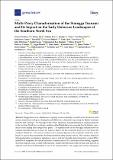Multi-proxy characterisation of the Storegga Tsunami and its impact on the early Holocene landscapes of the southern North Sea
Abstract
Doggerland was a landmass occupying an area currently covered by the North Sea until marine inundation took place during the mid-Holocene, ultimately separating the British landmass from the rest of Europe. The Storegga Event, which triggered a tsunami reflected in sediment deposits in the northern North Sea, northeast coastlines of the British Isles and across the North Atlantic, was a major event during this transgressive phase. The spatial extent of the Storegga tsunami however remains unconfirmed as, to date, no direct evidence for the event has been recovered from the southern North Sea. We present evidence of a tsunami deposit in the southern North Sea at the head of a palaeo-river system that has been identified using seismic survey. The evidence, based on lithostratigraphy, geochemical signatures, macro and microfossils and sedimentary ancient DNA (sedaDNA), supported by optical stimulated luminescence (OSL) and radiocarbon dating, suggests that these deposits were a result of the tsunami. Seismic identification of this stratum and analysis of adjacent cores showed diminished traces of the tsunami which was largely removed by subsequent erosional processes. Our results confirm previous modelling of the impact of the tsunami within this area of the southern North Sea, and also indicate that these effects were temporary, localized, and mitigated by the dense woodland and topography of the area. We conclude that clear physical remnants of the wave in these areas are likely to be restricted to now buried, palaeo-inland basins and incised river valley systems.
Citation
Gaffney , V , Fitch , S , Bates , M , Ware , R L , Kinnaird , T , Gearey , B , Hill , T , Telford , R , Batt , C , Stern , B , Whittaker , J , Davies , S , Sharada , M B , Everett , R , Cribdon , R , Kistler , L , Harris , S , Kearney , K , Walker , J , Muru , M , Hamilton , D , Law , M , Finlay , A , Bates , C R & Allaby , R G 2020 , ' Multi-proxy characterisation of the Storegga Tsunami and its impact on the early Holocene landscapes of the southern North Sea ' , Geosciences , vol. 10 , no. 7 , 270 . https://doi.org/10.3390/geosciences10070270
Publication
Geosciences
Status
Peer reviewed
ISSN
2076-3263Type
Journal article
Description
This project has received funding from the European Research Council (ERC) under the European Union’s Horizon 2020 research and innovation programme (ERC funded project No. 670518 LOST FRONTIERS, https://europa.eu/european-union/index_en, https://lostfrontiers.teamapp.com/). The project gratefully acknowledges the support of the Estonian Research Council (https://www.etag.ee/en/estonian-research-council/, Grant number: PUTJD829). PGS (https://www.pgs.com/) is acknowledged through provision of data used in this paper under license CA-BRAD-001-2017.Collections
Items in the St Andrews Research Repository are protected by copyright, with all rights reserved, unless otherwise indicated.

